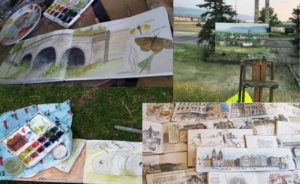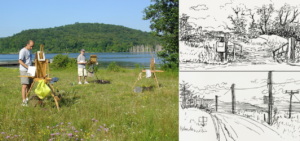A Brush with Nature this Autumn, Sketchbook Journaling
October 6, 2024 / Helen Kachur

The Art Guide staff celebrated another ‘travel milestone’ in their journey across southwest United States to New Mexico when they visited the Georgia O’Keeffe Museum, just north of Santa Fe. They were surprised to discover a large variety of very delicate O’Keefe sketches and insightful drawings that inspired her work, and often led to finished oil paintings. Encouraged by the experience, our travel crew considers in this article the value of sketchbook journaling in their own daily routines.
-
- There are moments in life that are like pivots around which your existence turns – small intuitive flashes, when you know you have done something correct for a change, when you think you are on the right track. I watched a pale dawn streak the cliffs with Day-glo and realised this was one of them. It was a moment of pure, uncomplicated confidence – and lasted about 10 seconds” Robyn Davidson, ‘Tracks’
Sketchbook journaling is a casual but regular commitment to draw, with less intent than that of thumbnail drawings prepared for a larger canvas. Journaling as a hobby can easily be done during a break in the day, coffee at a cafe, hike, waiting room, train ride or simply sitting in your backyard. Images are often accompanied by personal notes during a few quiet moments of unfiltered enjoyment. However, as a personal challenge it’s interesting to exaggerate specific drawing details to gain visual insight without the need for text.

If you’ve thought that journaling just isn’t right for your busy schedule, read on to learn about its ease and benefits, then see if it speaks to you. The materials are simple; a sketchbook, app, or combination of both. Try this simplified approach:
- Consider the right sketch option, a portable small notebook or app.
- Experiment with the best time of week to spend a few minutes alone to reflect and draw.
- Start simply with a single sentence or few drawn lines, then stop!
- For continuity keep to a basic template with headings, dates and general image location.
- Explore different styles of drawing and writing techniques.
- Avoid erasing or any corrections – be imperfect.
Sketching busy or large spaces is not always easy, but can easily be reduced into one composition by following a few smart tips. Art Guide team’s first recommendation is to keep design and materials simple. Purchasing a variety of modern-day art equipment is costly and often ignored. Rely on the basics to help enhance your focus in the moment and avoid distraction while capturing an image.
-
- “Everything that is painted directly and on the spot has always a strength, a power, a vivacity of touch which one cannot recover in the studio… three strokes of a brush in front of nature are worth more than two days of work at the easel.” Eugene Boudin, notes

When sketching, the Art Guide travel crew recommends organizing scenery into a few brief line movements to isolate key elements and compositional areas. At this early stage, it helps to plan perspective, direction of light for shadow and limit the subject. Gathering visual cues can also be benefited later with written text to mark the moment.
Do hesitate and do stop to draw, but then move on. Your sketches are ideas without commitment or mental critique, yet it’s helpful to be in the good habit of using a range of directional pencil/pen marks to distinguish grassy fields from water and a jagged rock face. This collection of images and text are note keeping and best if not held too precious, as your next insight could be lost due to overspent details.
In time, journaling can become a welcomed reflection that offers the benefit of a quiet stress-free moment and creative confidence builder. Our team’s research also found that journaling can help to boost visual awareness, focus on goals and easily inspire creative thought for future art work.
Wishing Art Guide readers happy journaling this autumn!


